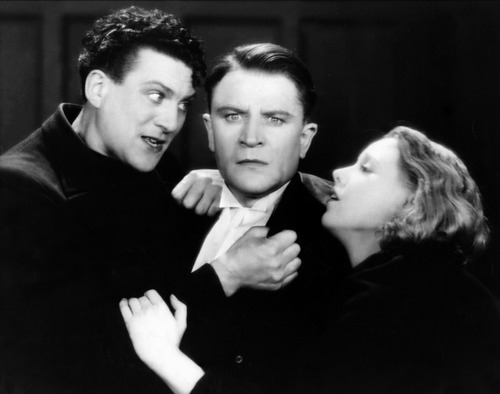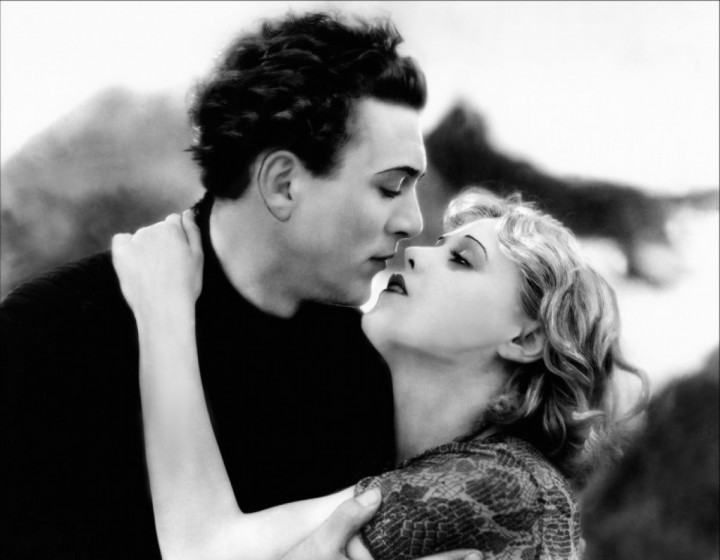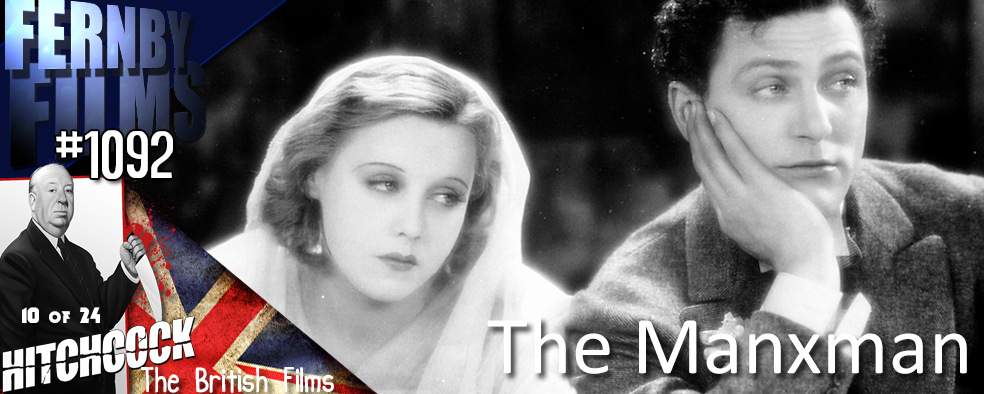Movie Review – Manxman, The (1929)
– Summary –
Director : Alfred Hitchcock
Year Of Release : 1929
Principal Cast : Carl Brisson, Malcolm Keen, Anny Ondra, Randle Ayrton, Clare Greet, Kim Peacock.
Approx Running Time : 110 Minutes
Synopsis: A fisherman and a rising young lawyer, who grew up as brothers, fall in love with the same girl.
*********
So that’s where Michael Bay got his story for Pearl Harbor!
The Manxman’s debut in 1929 would represent a watershed moment for Hitchcock’s directorial career. It would be his final silent film; his subsequent movie, Blackmail, would commence production as a silent film, but Hitch would go on to record the majority of the film with audio, a first for him, and one of the first for the British film industry. The transition from silent film to sound is, to my mind at least, accompanied by a shift in perceptive ability with the camerawork of the time, inasmuch that using dialogue (rather than interstitials, a cumbersome and often glaring break of scene throughout the early film years) allowed film-makers to use the frame and editing more perceptively, instead of locked still frames, Hitch would go on to use dolly and tracking shots in his early sound films, providing added technical width to his projects. So watching The Manxman is particularly jarring compared to the fluency of Blackmail’s more effortlessly poetic style; decidedly theatrical, melodramatic, and yet wholeheartedly Hitchcock at his most inventive, The Manxman’s love-triangle plot and keen performances by the leading trio make this a memorable, if altogether staid and spartan affair from the master director.
 Pete Quillam (Carl Brisson) is a lowly Isle of Man fisherman, madly in love with Kate (Anny Ondra), the daughter of the owner of the boat Pete uses to earn a living. Following a marriage proposal, Kate’s father, Old Ceasar (Randle Ayrton) refuses to give his blessing, since his future son-in-law lacks the means to support his daughter. Pete leaves for Africa to earn his riches, leaving Kate in the care of his best boyhood friend, up-and-coming lawyer Phillip Christian (Malcolm Keen), while he’s away. As the time passes, Kate and Phillip spend more time together, and eventually fall in love. So when word comes that Pete has died wile overseas, they decide to marry – only to learn that Pete isn’t dead, and he’s returned to the village a wealthy man. Torn between Pete and Phillip, Kate and her infant child must decide which of the men she truly wants to be with.
Pete Quillam (Carl Brisson) is a lowly Isle of Man fisherman, madly in love with Kate (Anny Ondra), the daughter of the owner of the boat Pete uses to earn a living. Following a marriage proposal, Kate’s father, Old Ceasar (Randle Ayrton) refuses to give his blessing, since his future son-in-law lacks the means to support his daughter. Pete leaves for Africa to earn his riches, leaving Kate in the care of his best boyhood friend, up-and-coming lawyer Phillip Christian (Malcolm Keen), while he’s away. As the time passes, Kate and Phillip spend more time together, and eventually fall in love. So when word comes that Pete has died wile overseas, they decide to marry – only to learn that Pete isn’t dead, and he’s returned to the village a wealthy man. Torn between Pete and Phillip, Kate and her infant child must decide which of the men she truly wants to be with.
If you read it in Maxwell Smart’s voice, it sounds so much like an “ahh, the old lovers-part-and-the-woman-falls-for-the-best-friend-only-to-find-that-the-first-man-isn’t-dead-after-all trick” comedy bit from Get Smart. It really is like that, a hoary old cinematic trope that offers unrequited melancholy tragedy in the face of a love triangle that, by rights, cannot end well for everyone. Pete and Phillip’s attraction to Kate, played by the absolutely radiant Anny Ondra (in the first of two films for Hitchcock; she would star in Blackmail the same year), is easy to understand, but because they’re best mates, it’s not easy for either of them to back away when it comes to the crunch. Now, if you’re a modern teenager, you’d equate that to an Edward-Bella-Jacob scenario – and The Manxman lacks werewolf or vampire overtones to make it slick and cool. Nope, The Manxman is an out-and-out dramatic firecracker from Hitch. [Sidebar: The title “Manxman” refers to the Celtic inhabitants of the Isle Of Man, where the story is set, who were known as Manx, a fact I had to look up because it’s a cool title and I expected something else.]
The film is based on and 1896 novel by Hall Caine (who is given credit in the opening titles), and although it was filmed previously in 1917, it’s Hitchcock’s version which remains the most popular of its iterations. Largely, I suspect, due to Hitch’s stunning camerawork on this film, a technical aspect I’m pleased to say is nearly on par with his achievements in The Lodger. Admittedly, The Manxman is a different film altogether in terms of hue and tone, but Hitch’s fondness for close-ups and actors looking directly down the barrel of the camera, as well as his sharp eye for framing and editing, I think they’re both equidistant in terms of visual impact, if not entirely character-driven motivations.
 Although the story is one we’ve seen in years since (by goodness, Michael Bay’s Pearl Harbor riffs on this narrative motif wholesale!), the film is given charm and elegance by the trio of lead actors, led most notably by the affable and charismatic Carl Brisson. Brisson returned to work with Hitch following a successful venture in The Ring (1927), and while he’s playing a slightly different character, his screen persona is equitably charming, enough to make me want to root for him to win back Kate when he arrives back on the scene. Malcolm Keen, lining up for his third Hitchcock film following the now-lost Mountain Eagle, and The Lodger (he played the cop, Joe), is suitably charming as Phillip, the secondary love-interest for Kate. Keen gives Phillip an affable masculinity – he’s not a cad, trying to steal his best friend’s girl, but it just kinda…. happens, you know how it is. There’s an empathy there which comes through in Keen’s performance.
Although the story is one we’ve seen in years since (by goodness, Michael Bay’s Pearl Harbor riffs on this narrative motif wholesale!), the film is given charm and elegance by the trio of lead actors, led most notably by the affable and charismatic Carl Brisson. Brisson returned to work with Hitch following a successful venture in The Ring (1927), and while he’s playing a slightly different character, his screen persona is equitably charming, enough to make me want to root for him to win back Kate when he arrives back on the scene. Malcolm Keen, lining up for his third Hitchcock film following the now-lost Mountain Eagle, and The Lodger (he played the cop, Joe), is suitably charming as Phillip, the secondary love-interest for Kate. Keen gives Phillip an affable masculinity – he’s not a cad, trying to steal his best friend’s girl, but it just kinda…. happens, you know how it is. There’s an empathy there which comes through in Keen’s performance.
Now, I can’t go any further without regaling you with the warm-hearted adoration I have for Anny Ondra, who quite simply makes this film brilliant. Her lush beauty, a radiance on screen captured by Hitch’s pregnant-pause style in this movie, are a delight – hell, I could just watch this woman read a book for two hours, I’d be so happy. Ondra is gorgeous, and her natural screen presence lifts the film above mediocrity. I get why Hitch wanted to work with her, and why the Nazi’s tried to insert themselves into her life during the War. She’s a superstar, with killer looks and come-hither eyes…. I know, I’m gushing, but watching this woman is truly the most wonderful thing a man can do alone in a cinema without being a pervert. Oh, and her portrayal of Kate is appropriately tormented between her love of Pete, and her love for Phillip – she’s genuinely ripped apart by her feelings for both men, and her loyalty to only one of them. Crushing.
The Manxman’s style is genteel for the most part, but thrusts into heady, downcast torment once the “triangle” part of the love story kicks in – specifically, one Pete comes “back” from the dead. A little like Tom Hanks’ character in Cast Away, who returns from his island sojourn to find his girl (Helen Hunt) has moved on with her life and married, Pete’s reaction to the news of Kate’s relationship with Phillip is heartbreaking when it needs to be (the reveal comes later in the movie), and the film’s detour into romantic tragedy is one of the stronger elements of the film. Something I’ve noticed with the silent films I’ve seen is that actors spend a lot of time acting “to the camera”, as if breaking the fourth wall; it’s not something we see a lot of in modern films, and it largely went out of fashion once sound provided a less obvious way to tell the story without having the camera take the place of a character in the film. The Manxman uses this effect considerably, but the film works best when it doesn’t. Pregnant pauses in a look, a glance, a palette of emotion on an actors face, provide the audience with an overtly prominent sense of being there, and although this is a product of the time, to my eyes it’s a clunky, often voyeuristic way of telling a story.
 As a product of its time, however, there’s loads in The Manxman to enjoy from a purely technical perspective. Weaving the narrative in and around studio sets and location filming (the film was shot in the Cornish village of Polperro, while many interior sequences were shot at Elstree Studios), Hitch’s eye for a story within each frame is strong here. He’s focused, he gets the sense of human drama around the plot, and his camerawork delivers. Although not as atmospheric as The Lodger, this film has enough of its own unique beauty and staging to make it legitimately one of the better silent films of Hitch’s career. Hitch’s use of framing, the square aspect we’ve come to know and love from this classic era of film, is hypnotic at times, as he uses fades, intercutting and a range of wide, mid and close shots to keep this melodramatic, occasionally overwrought love story pulsing along briskly.
As a product of its time, however, there’s loads in The Manxman to enjoy from a purely technical perspective. Weaving the narrative in and around studio sets and location filming (the film was shot in the Cornish village of Polperro, while many interior sequences were shot at Elstree Studios), Hitch’s eye for a story within each frame is strong here. He’s focused, he gets the sense of human drama around the plot, and his camerawork delivers. Although not as atmospheric as The Lodger, this film has enough of its own unique beauty and staging to make it legitimately one of the better silent films of Hitch’s career. Hitch’s use of framing, the square aspect we’ve come to know and love from this classic era of film, is hypnotic at times, as he uses fades, intercutting and a range of wide, mid and close shots to keep this melodramatic, occasionally overwrought love story pulsing along briskly.
The use of lighting in this film is largely flat throughout, with most scenes being well lit and devoid of large swathes of shadow akin to The Lodger’s velvety hues. The Manxman isn’t a thriller, but a drama, and Hitch instead uses the sets, the production design and a keen sense of performance to draw the viewer into the story, manipulating them into picking “a side” in this narrative via imagery that is genuinely cool. I mean, this is a film approaching it’s 90th birthday, for goodness sake! Although the story kinda didn’t do it for me in the sense that I couldn’t figure out what was going on, sitting back and taking in Hitch’s use of frame and camera was one of the best times I’ve had in a silent film – The Lodger included. His camera loves Anny Ondra, that’s for sure, and he focuses on her most of all, blessedly in multiple close-ups, and even group sequences have a sense of staged theatricality to them – Hitch was kinda like a young Stanley Kubrick, with the way he used the entire frame to tell a story, placing characters, items and props within the frame to be useful to either the actors to perform, or the audience to elicit a response. The Manxman is that good.
The Manxman is memorable for two things most of all: Anny Ondra’s luminous performance, and Hitchcock’s technical wizardry behind the camera. In many ways, it’s a shame he couldn’t make more films before sound came along, as his inventive use of the visual motif, bereft of spoken dialogue to pinpoint an emotion or plot point, is of the highest caliber here. Although a few of his silent films have been largely forgettable affairs, there’s no denying the director’s command of the picture to tell the story is anything less than exemplary. The Manxman is hugely recommended.





 Alfred Hitchcock on set
Alfred Hitchcock on set



